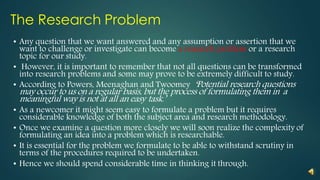The document outlines the process of formulating a research problem, emphasizing its critical role as the foundation of any research study. It discusses the importance of carefully choosing a manageable and relevant research question while considering factors such as interest, expertise, and ethical issues. The document provides a step-by-step guide on identifying a broad subject area, dissecting it into subareas, raising research questions, and formulating objectives to guide the research process.














